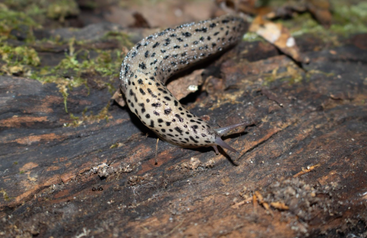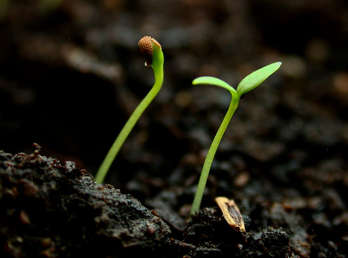 Slimy Little Weirdo While many of our local slugs love to nibble on our baby garden plants, the Leopard Slug, ‘Limax maximus’ has its own diet. They are detritivores, eating decaying plant matter as well as other slugs, making them a gardener’s friend! While the European native Leopard Slug is considered an invasive species to the US, we can’t help but be fascinated by its amazing habits! Consider its mating habits, if you haven’t already. These slugs are not only hermaphroditic, with each partner walking (slime-ing) away from their romantic endeavors pregnant with around 200 fertilized eggs, but they are also thrill seekers. In the evening, once they meet up with a suitable partner (I must admit I don’t know the criteria used by slugs to find partners) they take a romantic stroll together to the ledge of a rock or tree branch where they then lower themselves down on a rope made of their own slime and proceed to have marital relations while dangling in the air. All slugs are gastropods, distantly related to mollusks like squids, mussels, snails, and oysters. The leopard slug is one of the few that still pay homage to their lineage and have a vestigial shell, about the size and shape of a fingernail, located just under their skin. If you are ever in a slug caressing mood, you can actually feel the hidden shell by giving the slug a gentle massage. Also, they are edible. Janet Douberly is a slug masseuse at Downtown Greens. This article was first published in the January 2024 edition of Front Porch Magazine. To view the full publication visit www.frontporchfredericksburg.com
1 Comment
 Growing from Seeds Flower and vegetable gardening are great hobbies. Not only do they provide you with beauty and fresh food, but it’s a great way to get outdoors and connect with nature. However, as any gardener can attest to, it can become an expensive hobby. One way to mitigate costs is to start flower and vegetable plants from seeds. Seed starting might sound intimidating, but with a few materials or sometimes just seeds, you can start saving money and starting growing your own plants! There are several ways to start seeds. The easiest way for a beginner is to choose seeds that can be direct sown. Direct sowing seeds means simply placing the seeds in the ground once the chance of a hard frost has passed. To ensure that a plant or multiple plants come up, it’s best to place two to three times the number of seeds for each desired plant. For example, if you want two zucchini plants, place 2-3 seeds per plant location. Then once the seed germinate and become seedlings, you can choose the most robust looking seedling and remove the others. Some popular vegetables that can be direct sown are: zucchini, cucumbers, carrots, beets, and many herbs. Zinnias, wild bergamot, mountain mint are examples of flowers that can be direct sown. Another easy way to start seeds are native flower seeds that need cold stratification. Cold stratification means that the seeds need cold and moist in order to germinate. This can be accomplished in a couple of ways. One is to plant the seeds in the fall and hope for a cold and wet winter (some native plants, such as Jack in the Pulpit, require two cold and wet seasons). If you waited too long, you can also create the cold stratification conditions by using a medium, such as damp peat moss, and place the seeds in the refrigerator for the recommended time, usually 30-60 days, followed by sowing the seeds outdoors. A third common way to germinate seeds is by starting them indoors with enough lead time to allow the plants to germinate, grow, and then harden off, which means to allow the young plants time to get acclimatized to being outdoors. The items you will need are: seeds, seed starting soil, a container with a plastic dome and drainage hole, this does not need to be a special seed starting container, food clamshells work great, a light source, either a full spectrum fluorescent lights or a very sunny windowsill, and potting soil and containers to transplant seedlings. By reading the back of the seed packet for the desired plant, it will tell you how long it will take to start seeds indoors. For the Fredericksburg area, the last frost usually occurs around the middle of April. The key with growing seeds indoors is to monitor them daily to ensure that they are getting the correct amount of water, and to watch their growth. Starting seeds is a rewarding and economical way to add plants to your flower or vegetable garden. Also, if you end up not liking a particular flower or vegetable, then you haven’t invested a lot of money in it and can try something else the following year. Christie Hoerneman is President of the Board of Directors at Downtown Greens. This article was first published in the January 2024 edition of Front Porch Magazine. To view the full publication visit www.frontporchfredericksburg.com |
AuthorWrite something about yourself. No need to be fancy, just an overview. Archives
February 2024
Categories |
 RSS Feed
RSS Feed